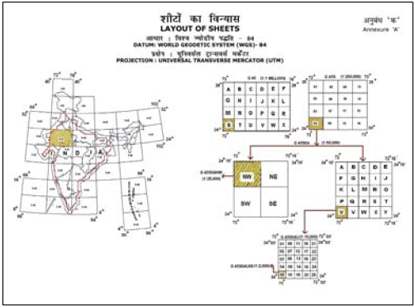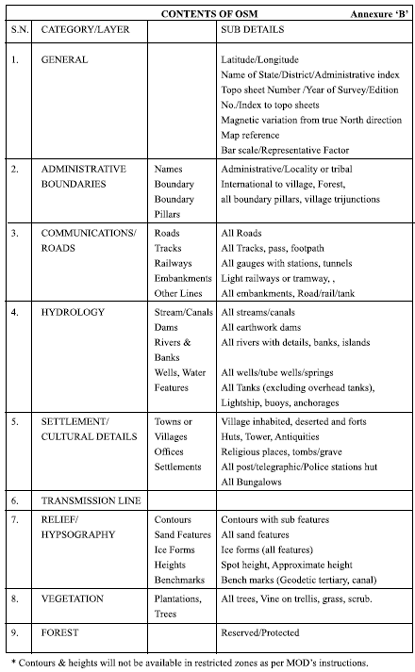| Policy | |
India’s National Map Policy Guidelines: A new move(ment)
|
|||||||||||||||
1. BackgroundThe Central Government announced the National Map Policy (NMP) on 19th May 2005. The NMP document authorizes Survey of India (SOI) to issue detailed guidelines on the implementation of the NMP. These guidelines are issued in the light of the above cited authorization. The guidelines are clarificatory in nature and does not create any new rights nor abridge any existing rights which are enforceable in courts of law. 2. Information on Maps and guidance of indentorsa) All up-to-date information on SOI maps shall be available at the various offices, map sales counters and Geospatial Data Centres (GDC) under the SOI. The information shall also be available on Survey of India website www.surveyofindia. gov.in created and maintained by the SOI. The information provided inter alia includes all relevant details of maps such as scale, information content, date of data capture, price, mode of data dissemination whether MOD clearance available for issue as Open Series Map (OSM) etc. The website also has a search engine by which the exact sheet number of a given locality can be traced by giving elementary details like name of district or any other prominent feature. SOI offices may be contacted for further information on OSMs. b) The lay out of OSM sheets on UTM projection and WGS 84 datum is shown in Annexure ‘A’. The annexure also shows the incidence of the existing topographical series on the OSM series. c) Data content: Approved data content of OSMs is given in Annexure ‘B’. d) Export of all maps/digital data in 1: 250K and larger scales through any means is prohibited vide Ministry of Finance (Department of Revenue) Notification No. 118-Cus./F.No.21/ 5/62-Cus. I/VIII dt. 4th May 1963. Digital Topograhical data will be licensed to only Indian individuals, organisations, firms or companies. 3. Sales/ Data Dissemination:(a) Analogue/Paper Maps: of all scales shall be made available from Survey of India (SOI) offices and Map Sales Counters on payment at prices as may be fixed by SOI from time to time. The list of such outlets, their addresses with telephone numbers shall be made available in the website www.surveyofindia. gov.in. These maps can also be sold by any retailer. Digitisation of SOI analogue/paper maps is strictly forbidden. (b) Map Transaction Registry (MTR): As stipulated in the National Map Policy, Survey of India will establish an online MTR for recording of all transactions relating to digital maps. Each user will be allotted a unique user ID and each transaction with a unique transaction ID. For all future correspondence, this user ID and Transaction ID should be referred. (c) Digital Maps: include both Raster and Vector forms. The ownership of all digital data vests solely with SOI and will be given only under licence against indent and on payment. Unauthorised copying and distribution of SOI digital data are strictly prohibited. All licenses will be issued through the Map Transaction Registry (MTR). The format of the licences is available in SOI web site www.surveyofindia.gov.in. The indents may be made in the prescribed proforma (appended as form A). 4. Licensing of Digital Maps:Digital data will be available in single/ multiple/ commercial licensing for general use, value addition and marketing. All digital maps will be provided with encryptions/mechanisms which may corrupt the data while copying unauthorisedly or while attempting the same. Every such attempt shall attract criminal and civil liability from the user without prejudice to the corruption of data or software/hardware for which the SOI will not be liable. SOI digital data will be licensed based on usage. Following are the categories: Digital Licence Publishing Licence Internet Licence Media Licence Value addition Licence Terms and conditions governing each of the licence is available in SOI web site www.surveyofindia.gov.in. 5. Procedure for value added productsInasmuch as the NMP is aimed at encouraging a flourishing geospatial industry and related knowledge services, there is much expectation from the industry to do value additions to the products of SOI. SOI encourages individuals/ industry to do value addition. Intending value adders will submit a business model indicating the products to be generated and marketing strategy and also execute a Memorandum of Agreement (MOA) with SOI. 6. Pricing of various products:(i) The SOI shall notify from time totime the price list of its standard products. (ii) The prices are subject to revision from time to time. (iii) An indentor has to pay the amount at the rate prevailing on the date of supply unless the indenter has already paid at the earlier rates. In other words, the indenter will not be eligible for supply on payment on the plea that the rates prevailing on the date of indent were lower. (iv) The SOI reserves its right for differential pricing, such as concessions to Universities, Research organizations, deserving NGO’s on the basis of predetermined policies, different prices between single and multiple user licenses etc. 7 e- Payment:Digital maps, on following the procedure, will be made available on variety of media like Compact Disks (CDs), DVD etc. Maps on 1:1M and smaller scale on compressed JPEG format will be available for download against online submission of licence agreement and on epayment. The self-guide provided in www.surveyofindia.gov.in shall enable an indentor to make e-payment and download the requisite maps. 8. Settlement of Disputes:In case any dispute arises on the applicability or interpretation of these guidelines between the SOI and any other person, the matter shall be referred to the Secretary, Department of Science & Technology, Government of India, whose decision shall be binding on both the parties. 9. Applicability of previous instructions:The Ministry of Defence has from time to time issued detailed guidelines on various aspects of map access and use. These instructions shall continue to hold good but for the modifications cited in the NMP. 10. General:(i) Copyrights of all SOI maps (both digital and analogue) vest exclusively with the SOI. Any person resorting to unauthorized copying or use or attempts to do so shall make him liable to criminal and civil liability under existing laws. (ii) While every effort will be made to ensure availability of maps of all areas containing all necessary details and with highest accuracy, SOI will not be responsible for any loss caused to any person on account of failure on any of the above factors or any other reason. (iii) The SOI reserves the right to add, delete, modify amend any or all of these guidelines without notice and without assigning any reason. |
|||||||||||||||
MTR sounds to be too rigid |
|||||||||||||||
Glacial progress |
|||||||||||||||
|















 (No Ratings Yet)
(No Ratings Yet)





